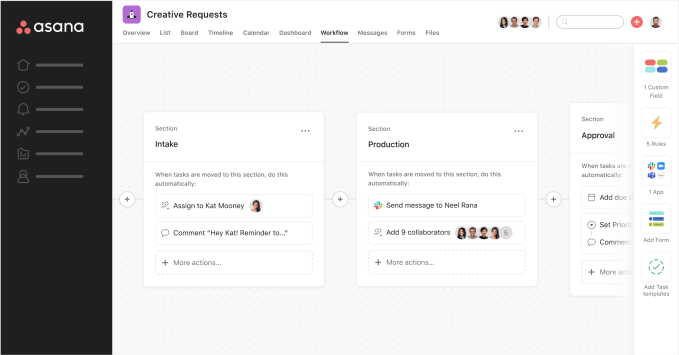Asana has always been about helping teams coordinate projects, but for the most part throughout the history of the company that has involved providing individual teams with the tools to manage a particular set of tasks to completion. Today, the company announced Asana Flow, a new set of workflow tools that help move work in an automated way within and across teams.
Unlike project planning tools, which define the steps to complete a project, workflow tools help move work in a logical way. So instead of simply assigning tasks, a project manager can create a reusable workflow that includes all of the steps, data and tools to complete and approve a project, explained Alex Hood, chief product officer at Asana.
Hood says that at its core Asana is a project management tool, and in a way, a workflow is a project that’s been put on repeat. With the new product, however, they are trying to extend that capability to automate the movement of work as it flows through a project.
“What we’re announcing is a bespoke workflow functionality that isn’t just running projects on repeat. It’s actually a UI where you can plan the workflow handoffs across your team, involving all the integrations that various folks use [along with] all the handoffs across cross-functional teams,” he explained.

Workflow Builder UI. Image Credits: Asana
The new Workflow Builder lets people in charge of projects create workflows with drag and drop components and build a set of automated processes that flow across teams. It also lets users define the data and handoff points within the workflow to have work move more smoothly and reduce the discussions related to work about work, letting it happen in an automated fashion.
The workflow can include components to interact with common tools like Salesforce, Slack, PowerBI and Zoom and content sources like Dropbox and Adobe Creative Cloud. It also includes the ability to create custom apps as needed to move work through internal systems or custom tools that may not be part of the standard integrations.
The company has created a library of common workflow templates to get you started, which you can build off of, but you can also create a template of any workflow and add it to the library for anyone in the company to use. Over time, Asana may also allow companies to share these templates outside the organization.
As work moves through the workflow, it is assigned to individual employees who have to carry out the tasks, and the company has created a page for each employee to see the tasks that are in progress, completed or even late that require their attention. “The home screen helps you figure out what is both urgent and important based on the goals of the company, and also the urgency of the workflows that you’re involved in,” Hood said.
The new workflow tools are the next logical extension of the Asana Work Graph the company has been built upon, enabling people to understand and take advantage of the connections across the organization, whether people, data, work or work components like meeting notes and documents.
